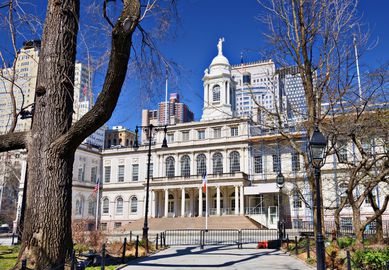

Built in 1812, in the French Renaissance Revival style, this elegant three-story mansion at 260 Broadway houses the office of New York's most vital administrator, the mayor. It is also a New York City Landmark and National Historic Landmark.
There had been two City Halls before the construction of the present building. The first went up in the 17th century, closer to the southernmost tip of Manhattan, when the city was still known as New Amsterdam, a Dutch colony. The second, which was known as Federal Hall, the site of George Washington's inauguration as America's first president, stood near Wall Street.
The current city hall, designed by architects John McComb, and Joseph-Francois Mangin, was erected in what is now City Hall Park. Before the American Revolution the park was a site for civic rallies and demonstrations, and thus served as a perfect location for the administrative center of the newborn nation's first capital.
The original material used for the building was brownstone, but after going through several reconstruction projects, City Hall was redone in Alabama limestone, in the mid-1950s, giving it the look it has today. It has a central pavilion and two wings. The entrance consists of a columned portico with a balustrade on top. There is another balustrade on the roof along with a domed tower, which was built during the last reconstruction in 1917.
The mayor's office itself is traditionally very small. It is located at the northwest corner on the first floor. Next to that is the Ceremonial Room, where the mayor holds group meetings. But the most sumptuous chamber in the edifice is the Governor's Room, where the mayor and other municipal authorities host and honor various dignitaries. Abraham Lincoln was the most important American to have ever been received in the room. In fact, the liberator of American slaves was received twice - the second time after his death. After Lincoln's assassination his tomb was transported from Washington to many cities in the north, one of which was New York, where he lay in state in the Governor's Room of City Hall, attracting hundreds of thousands of people who bid him a final farewell. The Governor's Room also contains an impressive collection of American portrait paintings and memorabilia such as George Washington's writing desk.
City Hall is also home of the New York City Council, which serves to balance the mayor's power. The council also creates the city's budget, puts forth legislation and interacts with the various city agencies. It has 51 members who represent the 51 council districts in New York's five boroughs.
In 2003 the City Council made unusual headlines. In a political battle for a council seat, contender Othniel Askew shot councilman James Davis from the balcony of the City Council Chamber. As the shots were going off, a police officer shot Askew. Both Askew and Davis died by the time they reached the hospital. At first they were buried in the same cemetery, but then Davis's family had his body exhumed and reinterred in a different burial ground. After the incident, Mayor Bloomberg had a metal detector installed at the entrance of City Hall.